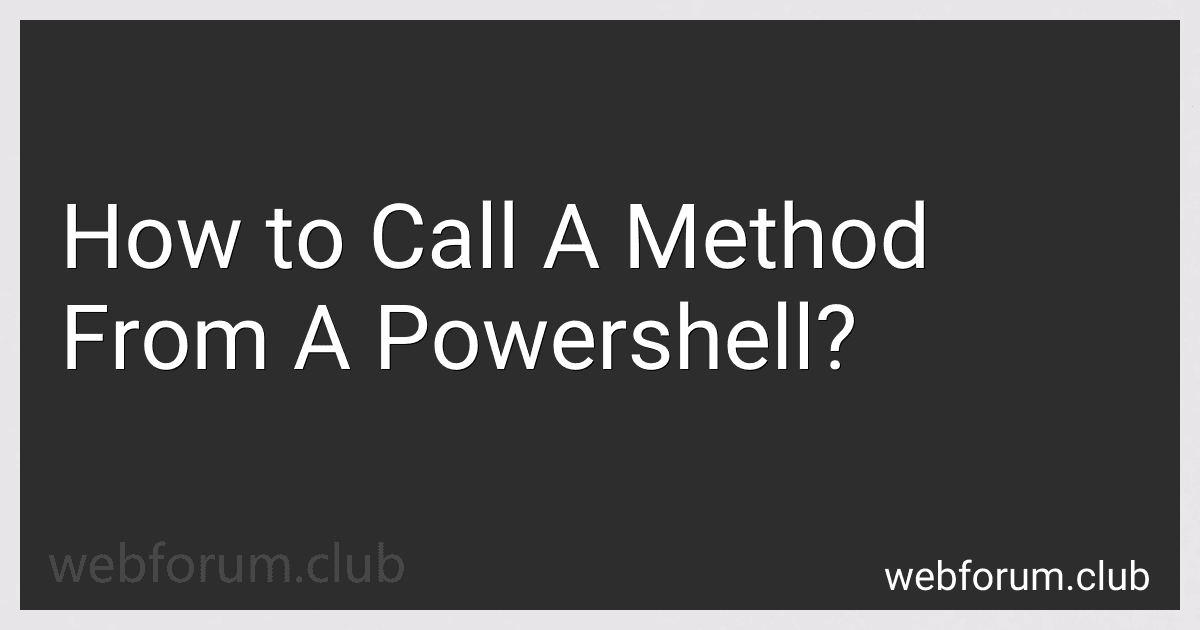To call a method from a PowerShell script, you first need to create an object that contains the method you want to call. This can be done using the New-Object cmdlet or by creating a custom object. Once you have the object, you can use the dot notation to access and call the method. For example, if you have an object called $myObject and it has a method called MyMethod, you can call it like this: $myObject.MyMethod(). Additionally, you can use the Invoke-Expression cmdlet or the & operator to call a method dynamically by providing the method name as a string. It is important to ensure that the method exists and is correctly spelled before attempting to call it.
How to utilize methods in PowerShell?
To utilize methods in PowerShell, follow these steps:
- Create an object: First, create an object that you want to perform methods on. This can be done using either a cmdlet that creates an object or by assigning a value to a variable.
- Access methods: To see the list of available methods for an object, use the Get-Member cmdlet. This will display all the methods associated with the object.
- Call a method: To call a method on an object, use the syntax $object.MethodName(). For example, if you have an object called $string and you want to convert it to uppercase, you can call the ToUpper() method like this: $string.ToUpper().
- Pass parameters: Some methods may require parameters to be passed. You can pass parameters to a method by including them within the parentheses. For example, if you have a method that takes a string parameter, you can call it like this: $object.MethodName("parameterValue").
- Display output: After calling a method, you can display the output by either storing it in a variable or using Write-Host or Write-Output cmdlets.
Overall, utilizing methods in PowerShell involves creating an object, accessing its methods, calling methods with or without parameters, and displaying the output.
How to pass parameters to a method in PowerShell?
To pass parameters to a method in PowerShell, you would need to define the method with parameters and then call the method with the specified arguments.
Here is an example of how to pass parameters to a method in PowerShell:
function Add-Numbers { param ( [int]$num1, [int]$num2 )
$sum = $num1 + $num2
Write-Output "The sum of $num1 and $num2 is: $sum"
}
Call the method and pass parameters
Add-Numbers -num1 5 -num2 10
In this example, the Add-Numbers method takes two parameters $num1 and $num2 which are two integers. When calling the method, we provide the values for these parameters by using the -num1 and -num2 flags followed by the values we want to pass.
You can pass parameters to a method in PowerShell by specifying the parameter names followed by the values you want to pass to those parameters when calling the method.
How to call a static method from a PowerShell script?
To call a static method from a PowerShell script, you would first need to load the assembly containing the method using the Add-Type cmdlet and then access the method using the :: operator.
Here's an example:
- Load the assembly:
Add-Type -AssemblyName "System.Windows.Forms"
- Call the static method:
[System.Windows.Forms.MessageBox]::Show("Hello World!")
In this example, we are loading the System.Windows.Forms assembly and calling the static Show method of the MessageBox class to display a message box with the text "Hello World!".
How to check if a method exists in PowerShell?
To check if a method exists in PowerShell, you can use the Get-Member cmdlet. Here's an example to check if a method called "TestMethod" exists on an object:
$object = "Hello" if ($object | Get-Member -MemberType Method -Name TestMethod -ErrorAction SilentlyContinue) { Write-Host "Method TestMethod exists on the object" } else { Write-Host "Method TestMethod does not exist on the object" }
In this example, we are checking if the method TestMethod exists on the string object "Hello". You can replace "Hello" with your specific object and "TestMethod" with the method you want to check for existence. The -ErrorAction SilentlyContinue parameter is used to suppress any errors that may occur if the method doesn't exist.
How to call a method from a PowerShell script?
To call a method from a PowerShell script, you can create an instance of an object that contains the method and then call the method using the following syntax:
$obj = New-Object ClassName $obj.MethodName()
Replace ClassName with the name of the class that contains the method you want to call, and MethodName with the name of the method you want to call.
Alternatively, if the method is a static method, you can call it directly using the following syntax:
[ClassName]::MethodName()
Replace ClassName with the name of the class that contains the static method and MethodName with the name of the method you want to call.
How to access a method in PowerShell?
To access a method in PowerShell, you need to first create an instance of the object that contains the method. Once you have an instance of the object, you can use the object's name followed by the method name, separated by a dot, to access and execute the method.
Here's an example to demonstrate how to access a method in PowerShell:
# Create a new object of type System.DateTime $datetime = Get-Date
Access and execute the AddDays method of the DateTime object
$newDate = $datetime.AddDays(5)
Output the result
$newDate
In this example, we create a new instance of the DateTime object using the Get-Date cmdlet. We then access the AddDays method of the DateTime object by using the object's name ($datetime) followed by a dot and the method name (AddDays). Finally, we pass an argument (5) to the AddDays method and assign the result to a new variable named $newDate.
You can access methods in a similar way for other types of objects in PowerShell as well.
